
Isopoda is an order of crustaceans that includes woodlice and their relatives. Isopods live in the sea, in fresh water, or on land. All have rigid, segmented exoskeletons, two pairs of antennae, seven pairs of jointed limbs on the thorax, and five pairs of branching appendages on the abdomen that are used in respiration. Females brood their young in a pouch under their thorax.
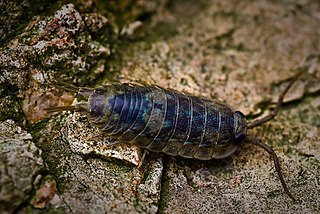
Ligia oceanica, the sea slater, common sea slater or sea roach, is a littoral woodlouse, living on rocky seashores of the european North Sea and Atlantic coastlines.
Chlamydephorus is a genus of air-breathing land slugs, terrestrial pulmonate gastropod mollusks in the family Chlamydephoridae. It is the only genus within the family Chlamydephoridae.

Areas of forest which grow in KwaZulu-Natal, South Africa mostly on south facing slopes in higher rainfall areas, and along the humid coastal areas. Different types of forest can be identified by their species composition which depends mostly on the altitude, latitude and substrate in which they grow. South facing slopes are favourable for the development of forest as they are more shaded, and therefore cooler and retain more moisture than the northern slopes. The extra moisture on the south slopes is not only favoured by forest trees, but also helps to prevent or subdue wildfires. Fires can also be blocked by cliff faces and rocks or boulders on these slopes, and by streams or rivers at the base of the slopes. The coastal regions are conducive to forest formation, because of high rainfall and humidity which are favoured by forest trees and also help to prevent or subdue fires. The rivers of the coastal areas are also broader than further inland, which may often prevent fires from spreading long distances, and fires generally burn uphill and therefore more often away from areas at low altitude.

The Maputaland-Pondoland-Albany Hotspot (MPA) is a biodiversity hotspot, a biogeographic region with significant levels of biodiversity, in Southern Africa. It is situated near the south-eastern coast of Africa, occupying an area between the Great Escarpment and the Indian Ocean. The area is named after Maputaland, Pondoland and Albany. It stretches from the Albany Centre of Plant Endemism in the Eastern Cape Province of South Africa, through the Pondoland Centre of Plant Endemism and KwaZulu-Natal Province, the eastern side of Eswatini and into southern Mozambique and Mpumalanga. The Maputaland Centre of Plant Endemism is contained in northern KwaZulu-Natal and southern Mozambique.

Bullia digitalis, the finger plough shell or plough snail, is a species of sea snail, a marine gastropod mollusk in the family Nassariidae, the Nassa mud snails or dog whelks.
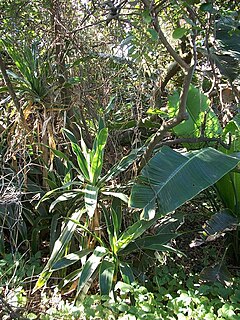
KwaZulu-Natal Dune Forest is a subtropical forest type that was once found almost continuously along the coastal dunes of KwaZulu-Natal, South Africa. This vegetation type develops in sheltered areas behind the littoral zone, where with some protection from the salt wind it may develop with canopies as tall as 30 m. It still exists in protected areas, but much has been degraded by human activity. Coastal dune forest covers approximately 1% of the land area of KwaZulu-Natal, and is a habitat type seriously threatened from human population pressure and development.

Ligia is a genus of isopods, commonly known as rock lice or sea slaters. Most Ligia species live in tidal zone cliffs and rocky beaches, but there are several fully terrestrial species in high humidity environments.
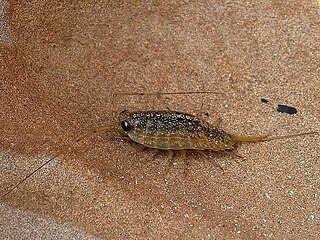
Ligia exotica, also called sea roach or wharf roach, is a woodlouse-like isopod, a sea slater in the family Ligiidae. It is found in various parts of the world living on rocky coasts and harbour walls just above high water mark.
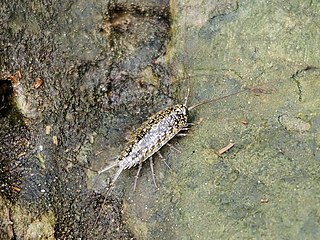
Ligia baudiniana is a woodlouse in the family Ligiidae. It has a coarsely granular surface and large eyes that are very close together.
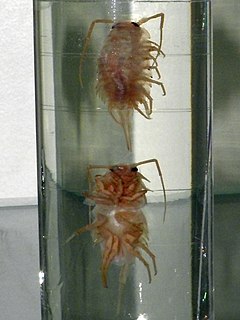
Ligia cinerascens is a woodlouse in the family Ligiidae.

Ligia diletata is a woodlouse in the family Ligiidae.
Ligia cajennensis is a woodlouse in the family Ligiidae. It has a relatively narrow body with a rough, grainy texture. It's a dark yellow/rust color, with lighter antennae and legs. Its eyes are brownish black.
Ligia cursor is a woodlouse in the family Ligiidae.
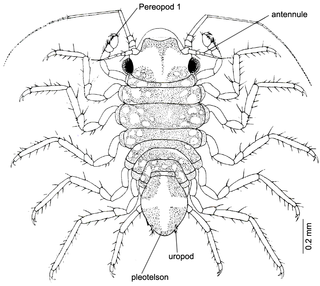
Uromunna sheltoni is a species of isopod first described by Brian Kensley in 1977. U. sheltoni is included in the genus Uromunna and family Munnidae. No subspecies are listed. The species was first collected by Peter Shelton of the University of Cape Town, for whom it is named.

Armadillidae is a family of woodlice, comprising around 80 genera and 700 species. It is the largest family of Oniscidea, and one of the most species-rich families of the entire Isopoda. Armadillids generally have a strongly convex body shape, with some rather shallowly convex. Like members of the woodlice family Armadillidiidae, armadillids are capable of enrolling into a sphere (conglobation), and are commonly known as pill bugs. Armadillids differ from the Armadillidiidae in that the antennae are fully enclosed within the sphere.

Anilocra capensis is a species of parasitic isopod in the family Cymothoidae. It is endemic to southern Africa. The species preferentially attaches itself to the hottentot.
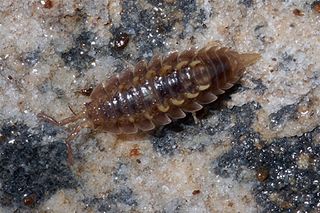
Deto echinata, the horned isopod, is a species of air-breathing isopod, or woodlouse, in the family Detonidae. It inhabits seashores in southern Africa and on some oceanic islands.













